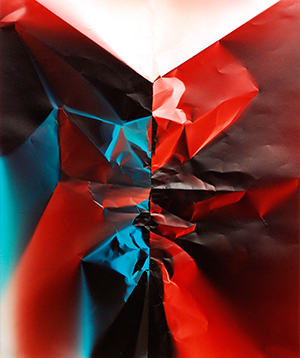Projects & Proposals
by Ellen Carey
My Sparkling Self
My Sparkling Self takes visual and conceptual cues for the project’s centerpiece from one of the first instant “selfies” (1977), a series of six Polacolor self-portraits by (and of) Ellen Carey, combined with “glitter” nail polish on each surface. This “sparkle” pre-dates the current “glitter” cultural vogue of beauty products (Revlon, Maybelline, Chanel, MAC) found in a rich range of brands whereby nails and the wearer’s polish are individualized. (more)
Read Complete Essay
Women of Colour:
Anna Atkins, Color Photography and Those Struck by Light
My research on the origins and history of color photography noted an absence that prompted a question: “Where would color photography and women practitioners be without the work of Anna Atkins?" The British Victorian, Anna Atkins (1799-1871), was the first woman photographer, albeit cameraless, and the first in color, using the cyanotype, a method that yielded a Prussian blue. Sir John Herschel, the British scientist, taught her his method. She partnered it with Talbot’s photogram (1834) — his paper negative image, a ghostly outline of the object, such as fern leaf or lace, in non-color, produced a palette of earthy browns. Gender codes of Atkins’ blue/feminine versus Talbot’s brown/masculine (italics mine) underscore these divisions of content, context, and concept, adding to the discourse around male and female sight. (more)
Read Complete Essay
Disegno e Colore
The proposal covers an important 16th century dispute and argument among artists, including Titian and Michelangelo, between a “disegno e colore” — a drawing and a color — spontaneity contrasted with careful planning. The subjects of my project's title, Disegno e Colore, revisit and continue this discourse in photography. They complement my conceptual and contextual foundation in characteristics and processes, specific to the medium, as they relate to drawing vis-à-vis the cliché-verre method and to color, by way of the cyanotype process. These two vintage, cameraless techniques visually underscore rich, historical aspects of Disegno e Colore. (more)
Read Complete Essay
To Paris With Love
To Paris with Love is a site-specific installation of 130 Polaroid negatives representing the total number of deaths in the recent Paris attacks, as well as the 12 killed in the Charlie Hebdo massacre, plus the 4 Jewish hostages who were murdered during a siege at a Hyper Cacher supermarket in a suburb of Paris. The large, grey negative is evocative of a headstone, while Polaroid’s matte patina echoes the lichen of the stone’s physical surface. The empty rectangle stands for the absence of the individual. In photography, a traditional portrait includes the person’s head and shoulder, a visual presence. Here, it is absent. (more)




